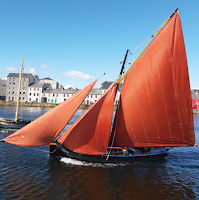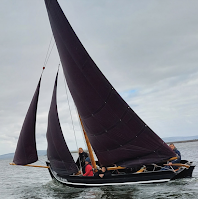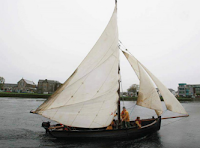COMPANY HISTORY
The Galway Hooker Sailing Club was founded in the early 1970s with the aim of promoting and preserving the traditional boats and nautical culture of the region. The club has played a key role in reviving interest in the Galway Hooker and helping to keep the tradition alive.
Today, the Galway Hooker Sailing Club is a thriving community of sailors, boat builders and enthusiasts dedicated to preserving the rich maritime heritage of Ireland's west coast. The club regularly organizes events and sailing races, and its members participate in competitions and festivals around the country and further afield.
As well as promoting the Galway Hooker, the club is also involved in conservation and environmental education initiatives, helping to raise awareness of the importance of protecting the marine environment and promoting sustainable practices in the fishing industry.
The Galway Hooker is a traditional fishing boat from the west coast of Ireland, particularly the Galway Bay Area. The boat's design is believed to date back to the 18th century and was originally used for fishing for herring, mackerel and other fish in the rough seas off the west coast.
TYPES OF BOATS
Four types of ships are distinguished, all with names of Irish origin.
Anam Cara
Anam Cara was built as a bád iomartha (row boat) around 1900. The Casey brothers “Na Cathasaigh” on Mweenish Island, Carna who had also built Bád Churraoín, built the boat for Marcus Colm from Inis Fhínse, and it is said to have cost £5 at the time. It was named Naomh Ciarán and was 22ft long.

Asurnaí
Asurnaí Built as a bád iomartha (rowboat) by Máirtín Casey (Máirtín Ó Cathasaigh) in 1914 on Mweenish Island, Carna, Asurnaí is approximately 22’ in length. She was built for Joe Conaola of ‘Siopa Joe Conaola’ at Mace Pier, Carna.

An Lon Dubh
An Lon Dubh was built as a 22ft bád iomartha (row boat) around 1900 by Patrick Griffin (Peaitín Phatch Ó Gríofa) in Lettermore, Co. Galway. The boat was built for the Conneelys of Tuairín, Béal an Daingin. Patrick Griffin (Peaitín Phatch Ó Gríofa) is a grand uncle of Antaine Phat Willie Ó Gríofa, whose family now own and sail the Naomh Ina - a 28 ft Gleoiteog Mór built by Michael Staff Mac Donnacha in 2019.

Loveen
Loveen was built as a 22-foot rowboat (bád iomartha) by John Francis Reaney (John Mhichil a’ Ráinne) in 1925. John Francis Reaney also built MP Martin McDonagh’s Gleoiteog, called as well as the original Truelight owned by Martin Oliver.

Lovely Anne
There is no record on what year Lovely Anne was built in Blackweir on the northern shore of Clarinbridge Bay. The builder of Lovely Anne, Patrick Brannelly, drowned in Kinvara Bay on the 14th of October 1892. He was very young, only 33 years of age. Three of his other boats are still sailing today; Tónaí, Morning Star and Lovely Anne.

Nóra Bheag
Nóra Bheag....she was built as a 23ft Púcán in 1916 by Seán O ‘Donnell (Johnny Labhcáis Ó Domhnaill) at Long Walk, Galway City. O’ Donnell also built An Faoileán, Regina Coeli and Uí Breasail, to name but a few

EVOLUTION SHIPS
The histroy of boats in Galway began many centuries ago, when ancient local fishers began building small boats to navigate the region’s the rivers and lakes.
With the time, the naval industry began a to develop and ships began to become larger and more sophisticated. This was partly due to development of the engines during the years of 1880, this development allowed the boats travel with better velocity and comfortable. Ships began to be made of stronger materials, such as iron and steel, allowing them to withstand more salt water and climatic elements. This innovation allows ships to travel farther and deeper.
Advances in navigation contributed to the evolution of ships in Galway.
The navigation it was done more precisly thanks to the use of maps and nautical charts, thing that goes permet the mariners navegation and more security and knowledge. This allowed permet the ships to arrive the destinations more distant and open comercial routes.
In the acuallity the ships in Galway are moderns and sophistyics, builded with materials of last generation. This ships they were used for many activities, for exemple, to fish, to transport the goods and tourism.
CONSTRUCTION BOATS
The construction of ships in Galway is a tradition taht goes back to middle age. During the centurie XV, Galway began a build ships for satisfayer the increase of demand the martim transport in local ambit, national or international. The ships provide a quick way fast transport and eficient for move goods and persons through ocean. The ships were built with wood and steel, the principal ports of Galway are an imprtant comercial ports for the industry local.
In the midle centurie eighteen began built ships steel forged. The ships are more resistent than the ships of wood and specially disegned to resist the corrosion of marine elements. Also, wrought iron ships were lighter which made them faster and better for more things.
The ships of Galway they also became famous for the quality and durability. This sihps were high quality and lasting, so they were a good investment for shipowners. During the nineteenth century, Galway ships were among the best in the world and were credited with being a major factor in the growth of Irish maritime trade.
Today, Galway boats remain an important part of the local industry. Shipbuilding in Galway is mainly done with wood and fiberglass, which makes them lighter and more resistant to corrosion. These boats are also built to the highest standard of quality and durability, making them an excellent choice for the marine industry.
TYPE OF FISHING
The Irish Sea offers a variety of sport fishing. The principal types of fishing are the surf casting, the underwater fishing and the deep fishing. Surf casting is practiced from shore, while spearfishing and deep-sea fishing require a trap net. To fish in the Irish Sea, you will need a fishing permit, which can be purchased at local tourist offices. Anglers need a valid saltwater fishing license. The fishermen need a specialized team, fishing rod, rollers, fishhook and utensils to collect the fish.
WAY OF FISHING
Galway it is home to some of the best fishing in Europe. It is a world famous fishing destination for anglers of all skill levels. From the rod fishing to fishing height fishing, Galway offers a variety of environments to satisfy all of the wishes of the fishermen from all of ability levels.
Galway is a perfect area for the height fishing. Understand a variety of environments where the fishermen can catch mostly deep water fish. Even though the best time for height fishing is between spring and autumn, the fishermen can enjoy the fishing all the year.
Also the height fishing, the rod fishing is extremately popular in Galway. The fisherman can enjoy the rod fishing in rivers, lakes and estuaries. The rod fishing is a funny and relaxing way to enjoy the natural environment and catching fish like salmon, walleye…
The fishermen can enojoy the trawl fishing too, the fishermen can catch a lot of fish species like the turbot, the sea bass and the cod. The trawl fishing is a very good idea to enjoy the natural environment too and catch the bigger fish.
Also these three main forms of fishing, the fishermen in Galway can also enjoy line fishing.



.jpg)
.jpg)
.jpg)

.jpg)